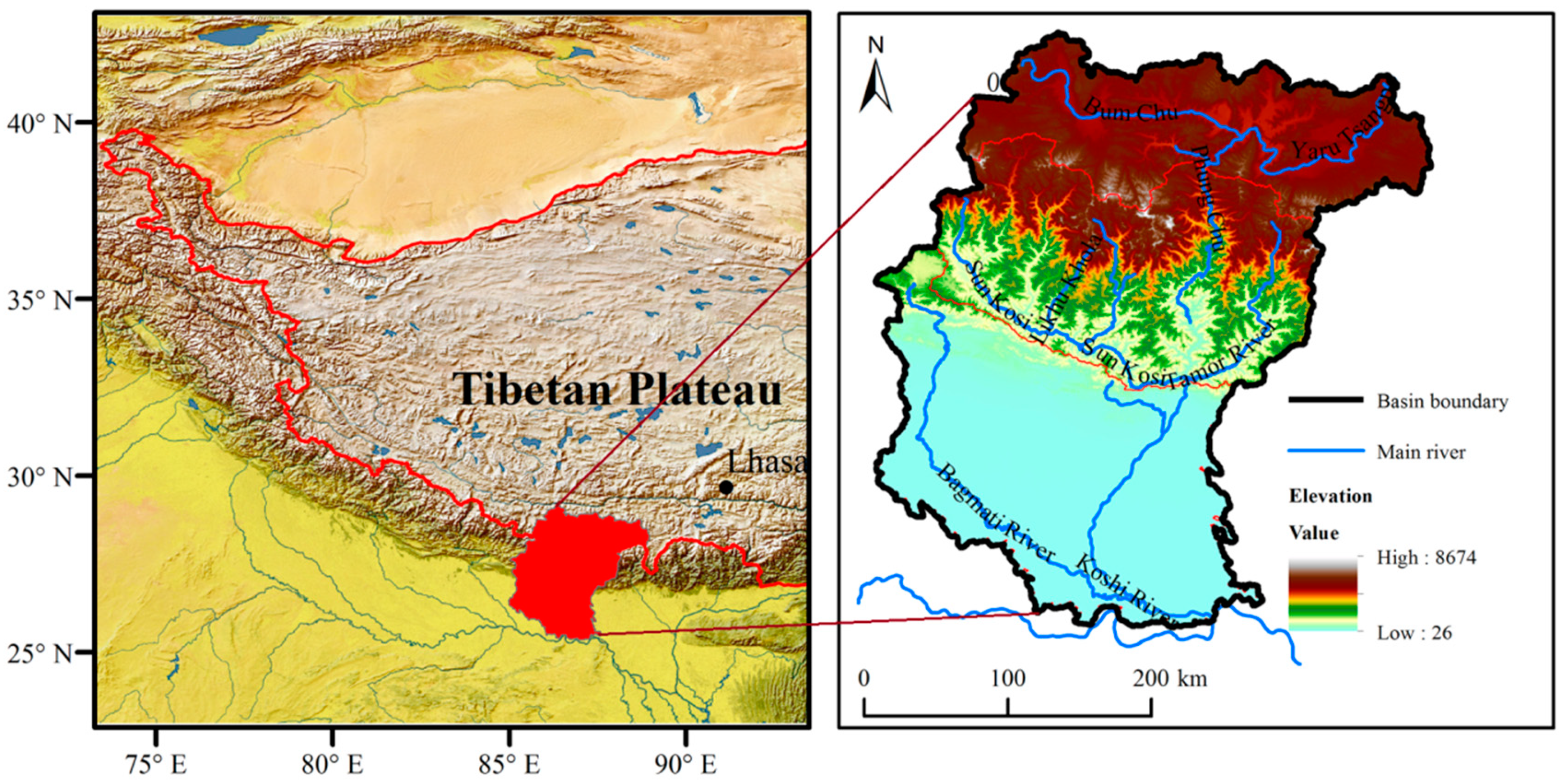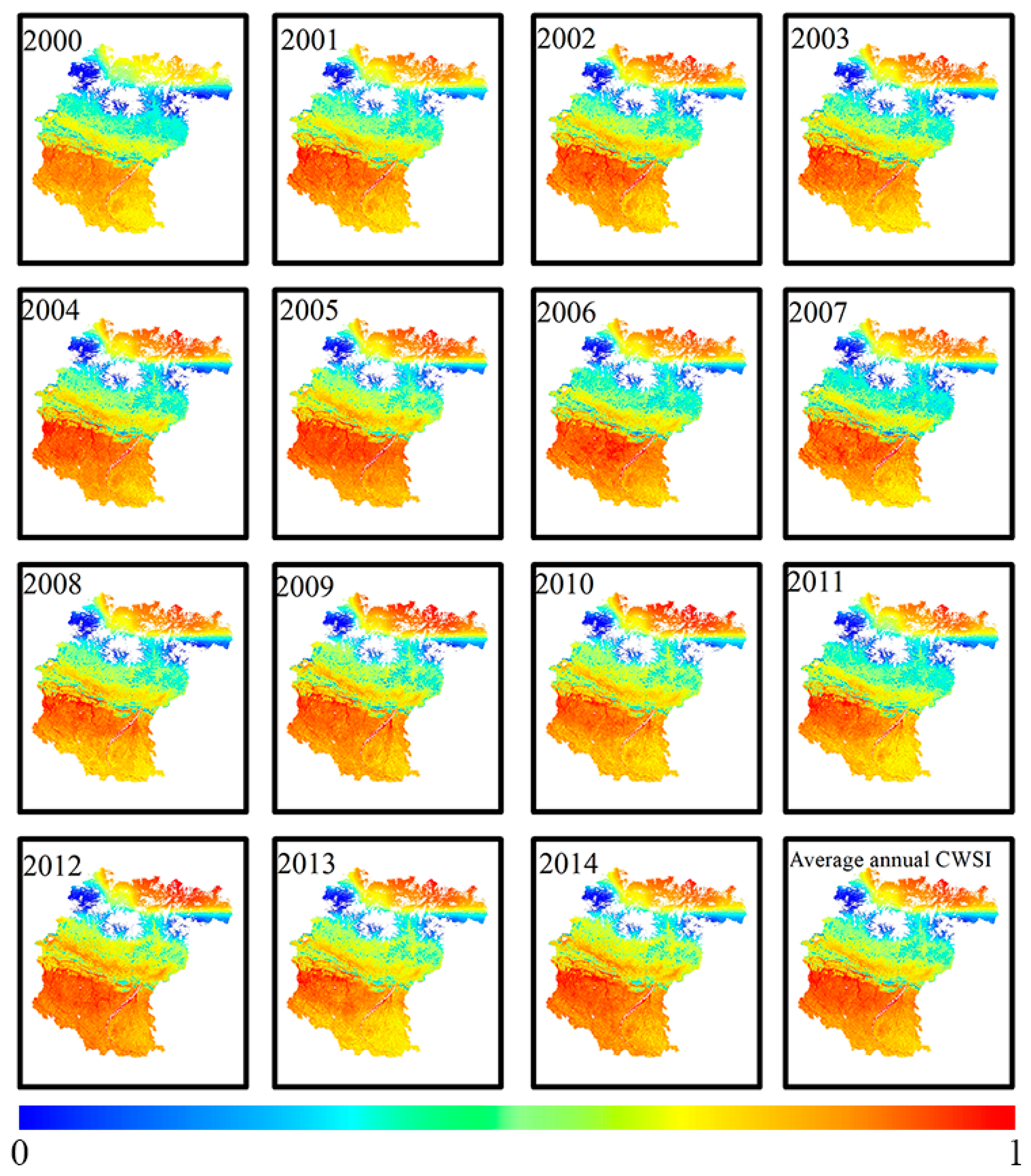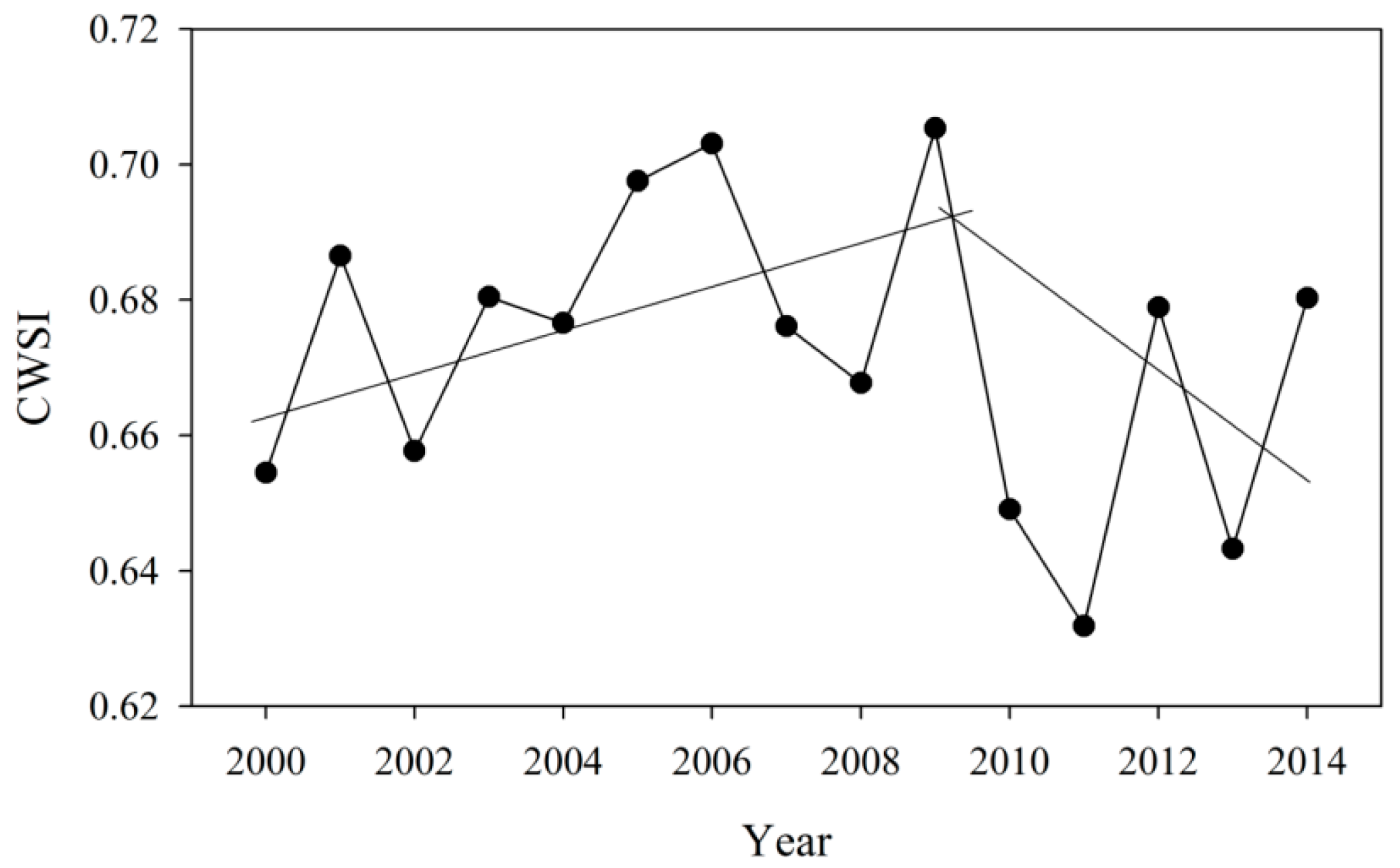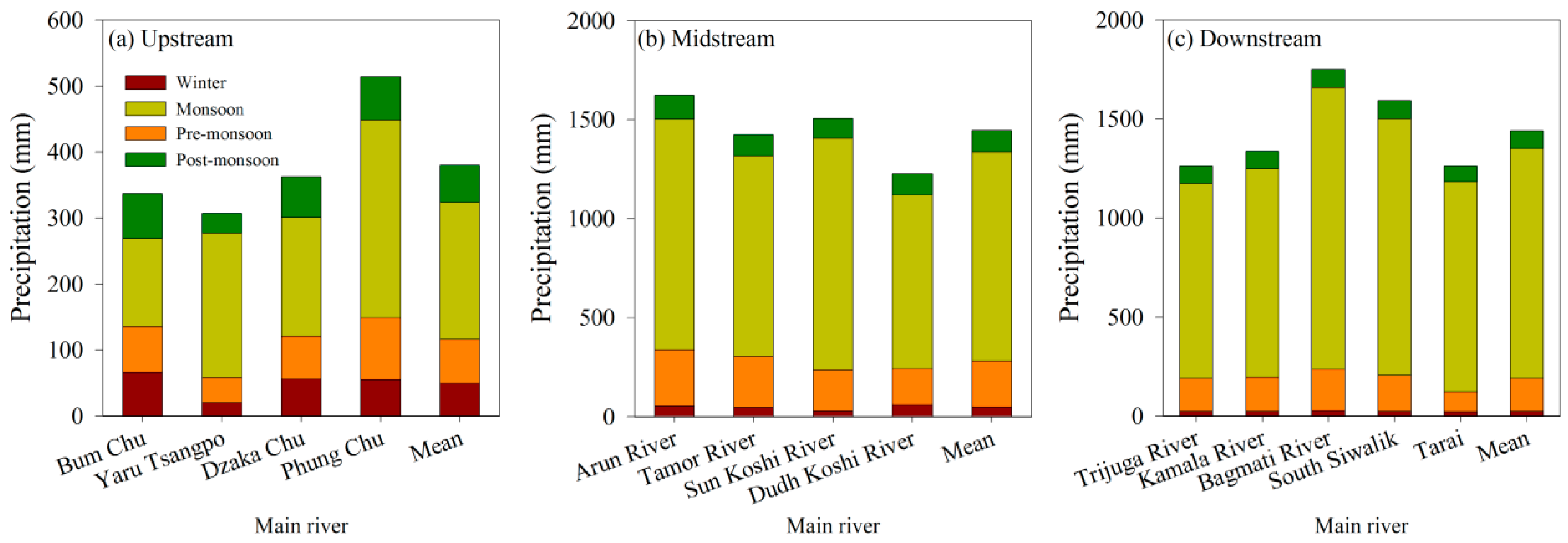Spatio-Temporal Analysis of Drought Variability Using CWSI in the Koshi River Basin (KRB)
Abstract
1. Introduction
2. Materials and Methods
2.1. Study Area
2.2. Data
2.3. Crop Water Stress Index (CWSI)
3. Results
3.1. Test of Drought Monitoring Results
3.2. Spatial Pattern of Drought
3.3. Temporal and Spatial Variation in Drought
4. Discussion
5. Conclusions
Author Contributions
Funding
Conflicts of Interest
References
- Vicente-Serrano, S.M.; López-Moreno, J.I.; Beguería, S.; Lorenzo-Lacruz, J.; Azorin-Molina, C.; Morán-Tejeda, E. Accurate computation of a streamflow drought index. J. Hydrol. Eng. 2012, 17, 318–332. [Google Scholar] [CrossRef]
- Piao, S.; Ciais, P.; Huang, Y.; Shen, Z.; Peng, S.; Li, J.; Zhou, L.; Liu, H.; Ma, Y.; Ding, Y.; et al. The impacts of climate change on water resources and agriculture in China. Nature 2010, 467, 43–51. [Google Scholar] [CrossRef] [PubMed]
- Wilhite, D.A. Drought as a natural hazard: concepts and definitions. In Drought: A Global Assessment; Wilhite, D.A., Ed.; University of Nebraska Press: Routledge, NY, USA, 2000; Volume 1, pp. 1–18. [Google Scholar]
- Lai, C.; Zhong, R.; Wang, Z.; Wu, X.; Chen, X.; Wang, P.; Lian, Y. Monitoring hydrological drought using long-term satellite-based precipitation data. Sci. Total Environ. 2019, 649, 1198–1208. [Google Scholar] [CrossRef] [PubMed]
- Liu, Y.; Zhu, Y.; Ren, L.; Yong, B.; Singh, V.; Yuan, F.; Jiang, S.; Yang, X. On the mechanisms of two composite methods for construction of multivariate drought indices. Sci. Total Environ. 2019, 647, 981–991. [Google Scholar] [CrossRef] [PubMed]
- IPCC. Climate Change 2013: The Physical Science Basis. In Contribution of Working Group I to the Fifth Assessment Report of the Intergovernmental Panel on Climate Change; Cambridge University Press: Cambridge, UK; New York, NY, USA, 2013. [Google Scholar]
- Trenberth, K.E.; Dai, A.; van der Schrier, G.; Jones, P.D.; Barichivich, J.; Briffa, K.R.; Sheffield, J. Global warming and changes in drought. Nature Clim. Change. 2014, 4, 17–22. [Google Scholar] [CrossRef]
- Zambrano, F.; Vrieling, A.; Nelso, A.; Meroni, M.; Tadesse, T. Prediction of drought-induced reduction of agricultural productivity in Chile from MODIS, rainfall estimates, and climate oscillation indices. Remote Sens. Environ. 2019, 219, 15–30. [Google Scholar] [CrossRef]
- American Meteorological Society. Meteorological drought. Bull. Am. Meteorol. Soc. 1997, 78, 847–849. [Google Scholar]
- Mishra, A.K.; Singh, V.P. A review of drought concepts. J. Hydrol. 2010, 391, 202–216. [Google Scholar] [CrossRef]
- Dutta, D.; Kundu, A.; Patel, N.; Saha, S.; Siddiqui, A. Assessment of agricultural drought in Rajasthan (India) using remote sensing derived Vegetation Condition Index (VCI) and Standardized Precipitation Index (SPI). Egypt. J. Remote Sens. Space Sci. 2015, 18, 53–63. [Google Scholar] [CrossRef]
- Niemeyer, S. New drought indices, options méditerranéennes. Sér. A: Sémin. Méditerr. 2008, 80, 267–274. [Google Scholar]
- Palmer, W.C. Meteorological drought. Research Paper No. 45; U.S. Department of Commerce Weather Bureau: Washington, DC, USA, 1965.
- McKee, T.B.; Doesken, N.J.; Kleist, J. The Relationship of Drought Frequency and Duration to Time Scales. In 8th Conference on Applied Climatology; American Meteorological Society: Anaheim, CA, USA; pp. 179–184.
- Paulo, A.A.; Rosa, R.D.; Pereira, L.S. Climate trends and behavior of drought indices based on precipitation and evapotranspiration in Portugal. Nat. Hazards Earth Sys. Sci. 2012, 12, 1481–1491. [Google Scholar] [CrossRef]
- Vicente-Serrano, S.M.; Lopez-Moreno, J.I.; Beguería, S.; Lorenzo-Lacruz, J.; SanchezLorenzo, A.; García-Ruiz, J.M.; Coelho, F. Evidence of increasing drought severity caused by temperature rise in southern Europe. Environ. Res. Lett. 2015, 9, 044001. [Google Scholar] [CrossRef]
- Wang, Z.; Zhong, R.; Lai, C. Evaluation and hydrologic validation of TMPA satellite precipitation product downstream of the Pearl River Basin, China. Hydrol. Proc. 2017, 31, 4169–4182. [Google Scholar] [CrossRef]
- Hsu, K.L.; Gao, X.; Sorooshian, S.; Gupta, H.V. Precipitation estimation from remotely sensed information using artificial neural networks. J. Appl. Meteorol. 1997, 36, 1176–1190. [Google Scholar] [CrossRef]
- Wang, L.M.; Liu, J.; Yang, L.B.; Deng, H.; Yang, F.G.; Ji, F.H. Principle, method and application of remote sensing monitoring of agricultural drought. Chin. Agricul. Inf. 2018, 30, 1–17. (In Chinese) [Google Scholar]
- Chen, W.Y.; Xiao, Q.G.; Shen, Y.W. Application of the anomaly vegetation index to monitoring heavy drought in 1992. Remote Sens. Environ. 1994, 9, 106–112. [Google Scholar]
- Deng, M.; Di, L.; Han, W.; Yagci, A.L.; Peng, C.; Heo, G. Webservice-based monitoring and analysis of global agricultural drought. Photogramm. Eng. Remote Sens. 2013, 79, 929–943. [Google Scholar] [CrossRef]
- Price, J.C. On the analysis of thermal infrared imagery: The limited utility of apparent thermal inertia. Remote Sens. Environ. 1985, 18, 59–73. [Google Scholar] [CrossRef]
- Jackson, R.D.; Kustas, W.P.; Choudhury, B.J. A reexamination of the crop water stress index. Irrig. Sci. 1988, 9, 309–317. [Google Scholar] [CrossRef]
- Sandholi, I.; Rasmussen, K.; Ersen, J. A simple interpretation of the surface temperature vegetation index space for assessment of surface moisture status. Remote Sens. Environ. 2002, 79, 213–214. [Google Scholar] [CrossRef]
- Yang, T.; Gong, H.L.; Li, X.J. Progress of soil moisture monitoring by remote sensing. Acta Ecol. Sin. 2010, 30, 6264–6277. (In Chinese) [Google Scholar]
- Wang, Z.; Wang, F.; Zhang, Y. Spatio-temporal Distribution Characteristics and Influencing Factors of Drought in Anhui Province Based on CWSI. J. Nat. Res. 2018, 33, 853–866. (In Chinese) [Google Scholar]
- Wang, Y.; Wang, S.; Zeng, H.; Cai, M.; Song, W. Drought Characteristic in the Weihe river Basin Based on Water Shortage Index of Crops. Arid Zone Res. 2014, 31, 118–124. [Google Scholar]
- Bai, J.; Yuan, Y.; Di, L. Comparison between TVDI and CWSI for drought monitoring in the Guanzhong Plain, China. J. Integr. Agricul. 2017, 16, 389–397. [Google Scholar] [CrossRef]
- Hussain, A.; Rasul, G.; Mahapatra, B.; Tuladhar, S. Household food security in the face of climate change in the Hindu-Kush Himalayan region. Food Secur. 2016, 8, 921–937. [Google Scholar] [CrossRef]
- Bhalme, H.; Mooley, D. Large-scale droughts/floods and monsoon circulation. Am. Meteorol. Soc. 1980, 108, 1197–1211. [Google Scholar] [CrossRef]
- Zhao, W.; He, J.L.; Wu, Y.H.; Xiong, D.H.; Wen, F.P.; Li, A.L. An analysis of land surface temperature trends in the central Himalayan region based on MODIS products. Remote Sens. 2019, 11, 900. [Google Scholar] [CrossRef]
- Shrestha, A.; Aryal, R. Climate change in Nepal and its impact on Himalayan glaciers. Reg. Environ. Chang. 2011, 11 (Suppl. 1), S65–S77. [Google Scholar] [CrossRef]
- Nayava, J.L. Rainfall in Nepal. Himalaya Rev. 1980, 12, 1–18. [Google Scholar]
- Pennan, C.; Luna, B.; Utsav, B.; Ambika, K.; Vaskar, D.; Shahriar, W. Impact of planned water resource development on current and future water demand in the Koshi River basin, Nepal. Water Int. 2015, 40, 1004–1020. [Google Scholar]
- Bharati, L.; Gurung, P.; Jayakody, P.; Smakhtin, V.; Bhattarai, U. The projected impact of climate change on water availability and development in the Koshi Basin, Nepal. Mountain Res. Dev. 2014, 34, 118–130. [Google Scholar] [CrossRef]
- Chen, N.S.; Hu, G.S.; Deng, W.; Khanal, N.; Zhu, Y.H.; Han, D. On the water hazards in the trans-boundary Kosi River basin. Nat. Hazards Earth Sys. Sci. 2013, 13, 795–808. [Google Scholar] [CrossRef]
- Zhang, Y.L.; Gao, J.G.; Liu, L.S.; Wang, Z.F.; Ding, M.J.; Yang, X.C. NDVI-based vegetation changes and their responses to climate change from 1982 to 2011: A case study in the Koshi River Basin in the middle Himalayas. Global Planet. Change. 2013, 108, 139–148. [Google Scholar] [CrossRef]
- Central Bureau of Statistics (CBS). National Population and Housing Census 2011; Central Bureau of Statistics: Kathmandu, Nepal, 2012.
- Mu, Q.Z.; Zhao, M.S.; Runing, S.W. Improvements to a MODIS global terrestrial evapotranspiration algorithm. Remote Sens. Environ. 2011, 115, 1781–1800. [Google Scholar] [CrossRef]
- Steven, W.R.; Mu, Q.Z.; Zhao, M.S.; Moreno, A. MODIS Global Terrestrial Evapotranspiration (ET) Product (NASA MOD16A2/A3). MODIS Science Team: Washington, DC, USA. Available online: http://www.ntsg.umt.edu/project/mod16 (accessed on 17 July 2017).
- Jackson, R.D.; Idso, S.B.; Reginato, R.J.; Pinter, P.J. Canopy temperature as a crop water stress indicator. Water Resour. Res. 1981, 17, 1133–1138. [Google Scholar] [CrossRef]
- Zhao, H.; Xu, Z.X.; Zhao, J. Development and application of agricultural drought index based on CWSI and drought event rarity. Tansactions Chin. Soc. Agricul. Eng. 2017, 33, 116–125. (In Chinese) [Google Scholar]
- Paudel, B.; Gao, J.; Zhang, Y.; Wu, X.; Li, S.; Yan, J. Factors in the Koshi River Basin of the Central Himalayas, Nepal. Sustainability 2016, 8, 933. [Google Scholar] [CrossRef]
- Dixit, A.; Upadhya, M.; Dixit, K.; Pokhrel, A.; Rai, D.R. Living with Water Stress in the Hills of the Koshi Basin, Nepal; ICIMOD: Lalitpur, Nepal, 2019. [Google Scholar]
- Agarwal, A.; Babel, M.; Maskey, S. Analysis of future precipitation in the Koshi river basin, Nepal. J. Hydrol. 2014, 513, 422–434. [Google Scholar] [CrossRef]
- Uddin, K.; Murthy, M.S.R.; Wahid, S.M.; Matin, M.A. Estimation of Soil Erosion Dynamics in the Koshi Basin Using GIS and Remote Sensing to Assess Priority Areas for Conservation. PLoS ONE 2016, 11, e0150494. [Google Scholar] [CrossRef]
- Bharati, L.; Gurung, P.; Maharjan, L.; Bhattarai, U. Past and future variability in the hydrological regime of the Koshi Basin, Nepal. Hydrol. Sci. J. 2016, 61, 79–93. [Google Scholar] [CrossRef]
- Peng, G.; Liu, Y.; Zhang, Y. Research on characteristics of drought and climatic trend in Yunnan Province. J. Catastrophol. 2009, 24, 40–44. [Google Scholar]
- Bartlett, R.; Bharati, L.; Pant, D.; Hosterman, H.; McCornick, P. Climate change impacts and adaptation in Nepal. Iwmi Work. Pap. 2010, 12, 109–116. [Google Scholar]








| ID | Precipitation (mm) | Temperature (°C) | Potential Evapotranspiration (mm) | Dryness | CWSI |
|---|---|---|---|---|---|
| Upstream | 658.8 | 3.8 | 739.2 | 1.19 | 0.65 |
| Midstream | 1373.1 | 13.9 | 864 | 0.6 | 0.57 |
| Downstream | 1137.73 | 25.48 | 1616.6 | 1.49 | 0.76 |
© 2019 by the authors. Licensee MDPI, Basel, Switzerland. This article is an open access article distributed under the terms and conditions of the Creative Commons Attribution (CC BY) license (http://creativecommons.org/licenses/by/4.0/).
Share and Cite
Wu, H.; Xiong, D.; Liu, B.; Zhang, S.; Yuan, Y.; Fang, Y.; Chidi, C.L.; Dahal, N.M. Spatio-Temporal Analysis of Drought Variability Using CWSI in the Koshi River Basin (KRB). Int. J. Environ. Res. Public Health 2019, 16, 3100. https://doi.org/10.3390/ijerph16173100
Wu H, Xiong D, Liu B, Zhang S, Yuan Y, Fang Y, Chidi CL, Dahal NM. Spatio-Temporal Analysis of Drought Variability Using CWSI in the Koshi River Basin (KRB). International Journal of Environmental Research and Public Health. 2019; 16(17):3100. https://doi.org/10.3390/ijerph16173100
Chicago/Turabian StyleWu, Han, Donghong Xiong, Bintao Liu, Su Zhang, Yong Yuan, Yiping Fang, Chhabi Lal Chidi, and Nirmal Mani Dahal. 2019. "Spatio-Temporal Analysis of Drought Variability Using CWSI in the Koshi River Basin (KRB)" International Journal of Environmental Research and Public Health 16, no. 17: 3100. https://doi.org/10.3390/ijerph16173100
APA StyleWu, H., Xiong, D., Liu, B., Zhang, S., Yuan, Y., Fang, Y., Chidi, C. L., & Dahal, N. M. (2019). Spatio-Temporal Analysis of Drought Variability Using CWSI in the Koshi River Basin (KRB). International Journal of Environmental Research and Public Health, 16(17), 3100. https://doi.org/10.3390/ijerph16173100





